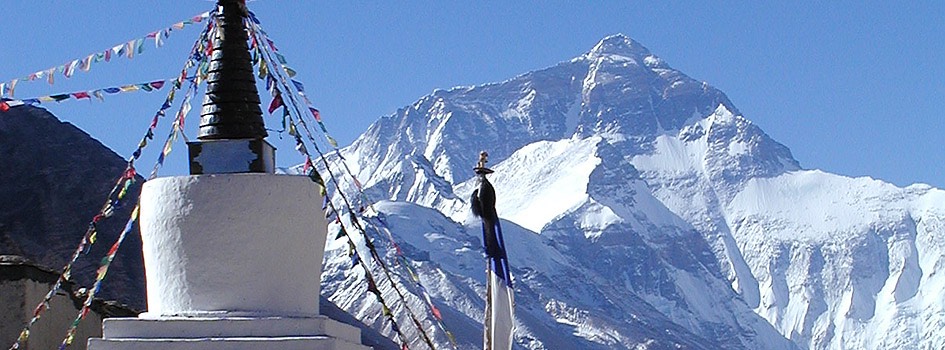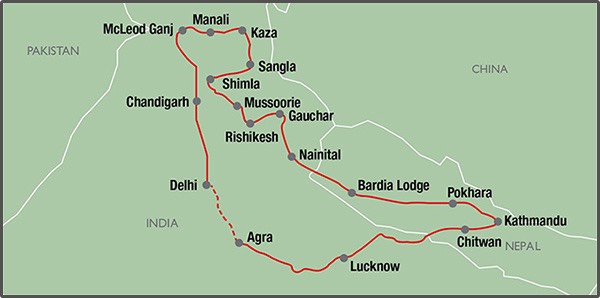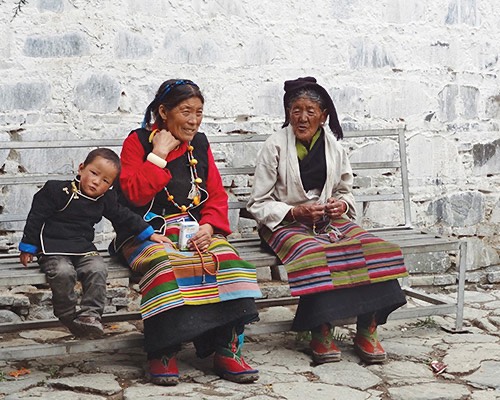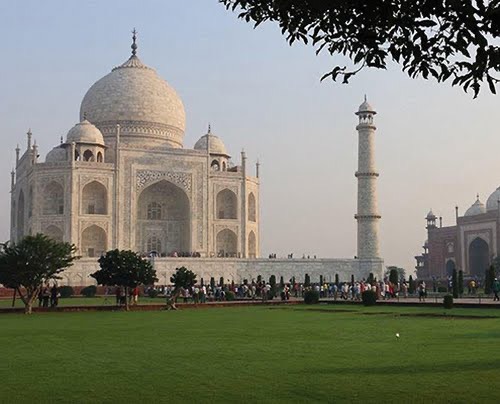
Day One: Delhi – Chandigarh info and routing provided directly by ERA
After a night luxuriating in the colonial splendour of the Imperial Hotel, our intrepid crews must prepare themselves – and their vehicle’s horn - for a very different road traffic system. The surprisingly calm, free-flowing, straight and flat national highway is a good introduction to local driving habits where driving intention and existence is indicated by use of the horn. A silent car is a worry to the locals who will assume the driver is deaf or… lacking a pulse!
Once out of Delhi, crews make their way to the foothills of the Himalayas and into Chandigarh which takes its name from the Hindu goddess, Chandi – by all accounts, quite a feisty deity! Chandigarh was also one of the first ‘planned’ cities of independent India and was designed in the 1950s by one of the pioneers of modern architecture; Swiss-French architect, Le Corbusier.

Day Two: Chandigarh – McLeod Ganj
Shortly after leaving Chandigarh, the route becomes more rural before turning off into even more remote country, through low hills and back roads to approach the base of the Himalaya range. Then, twisty narrow roads dominate onwards to McLeod Ganj; the residence in exile of His Holiness, the 14th Dalai Lama and home to a large population of Tibetans, including maroon-robed monks and nuns. The city bustles with life and attracts thousands of travellers keen to immerse themselves in the spiritual and alternative atmosphere that is entrenched in the heart of this truly holy place. Our hotel for the night hangs over the valley and provides a spectacular view.
Day Three: McLeod Ganj - Manali
Retracing their wheel tracks to join the road along the base of the mountains, crews then push onwards through many teeming market towns to stop for lunch at a splendid, although slightly crumbly, colonial hotel - think Best Exotic Marigold Hotel!
After lunch, the route turns off the highway onto a very special traffic-free asphalt road with breath-taking views. This part of the route features on no maps and was revealed to us by local expert, Manjeev Singh Bhalla and we have named it ‘Manjeev’s Ridge’ in his honour. From here, the rest of the day offers crews a truly top-class driving experience with more spectacular scenery, climbs and descents until coming to our overnight halt in Manali.
Day Four: Manali Rest Day
Manali is one of the most visited tourist destinations in India with lots for crews to see and do. Sitting at 2,050m above sea level, the hill station resort is very Swiss in appearance and is overlooked by the towering, snow-capped peaks of the Himalayas. For those seeking more in the way of thrills on their day off, there’s mountain biking, trekking, paragliding, skiing… the list goes on! But for those who fancy a spot of more laid-back relaxation, there are plenty of beautiful natural landscapes and historical monuments to soothe the senses.
Day Five: Manali – Kaza
Hopefully refreshed and restored after yesterday’s rest day, crews are advised that today is where things start to get serious! Leaving Manali for the Spiti Valley, the route will take us over the Rohtang Pass (3,979m) and then onto the Kunzum Pass (4,590m). These passes are only open during a short summer window and the roads provide a driving experience par excellence with countless hairpins that climb relentlessly and stunning scenery that provides a visual feast for those brave enough to take their eyes off the road.
Once into Kaza our accommodation for the night is simple but clean with good food and drinks guaranteed.
Day Six: Kaza – Kaza
Our local expert, Manjeev, has once again come up trumps and the majority of today’s shorter, more relaxing, traffic-free and circuitous route is absent from any map and our progress will be sheltered by the high mountain peaks surround the area. To demonstrate our sincere thanks for his invaluable help, this part of the route has been dubbed ‘Manjeev’s Loop’.
Day Seven: Kaza – Sangla
The route today follows the Spiti valley down to where it grazes the Tibetan border, then turns south west to follow the Sutlej valley before crossing the river Sutlej and entering the Baspa valley, which is reputed to be the most scenic in the Himalayas. The route continues to the overnight halt in the small town of Sangla which, with its mild climate and nutrient rich soil, produces the world’s best apples! Rally doctors can take the day off…
Day Eight: Sangla – Shimla
Today’s route retraces itself to the main Sutlej valley and re-joins the main road to continue along the banks of the Sutlej river before a final ascent and on towards Shimla and our hotel for the night – the magnificent and highest – both in altitude and quality - luxury hotel in the Himalayas.
Day Nine: Shimla Rest Day
Crews can take the opportunity today to explore one of northern India’s most popular hill stations – Shimla. Set high up among hills and woods, Shimla was once the summer home of British India and the uppermost parts of the city reflect this with many buildings decidedly Victorian in design. Snuggled among the colonial architecture are many historic temples and churches and the mix of the two is fascinating. The Mall, stuffed full of local handicraft shops and the Lakaar Bazaar which specialises in wooden toys and crafts are well worth a visit and finally, railway enthusiasts might find the 100km narrow-gauge railway of interest. Completed and opened in 1903, the railway is now a registered UNESCO World Heritage Site and runs from Shimla to Kalka.
Day Ten: Shimla - Mussoorie
Today, the route will be mostly… twisty! It winds its way through valleys and over passes as it heads south east through some remote and wild country towards the ‘Queen of Hill Stations’ at Mussoorie.
Set at 2005m above sea level, Mussoorie is renowned for its scenic beauty and was founded in 1823 by Lt. Frederick Young of the East India Company. Lt. Young was so bowled over with the beautiful surroundings after spending time there on a shooting trip, he decided to build a hunting lodge on the Camel’s Back Road. He also established the first Ghurka Regiment and planted the first potatoes in the area.

Day Eleven: Mussoorie – Rishikesh
Marking a change from the distinctly ‘Alpine’ feel of recent days, today’s roads are rural and the route circuitous.
Rishikesh is the seventh largest city in India and sits in the Himalayan foothills beside the River Ganges. Known as the Yoga Capital of the World, this is where The Beatles attended an advanced Transcendental Meditation training course at the ashram of Mahareshi Mahesh Yogi in 1968.
Day Twelve: Rishikesh – Rudraprayag
With chakras fully restored, our crews head back into the hills today to the small town of Rudraprayag which is described as ‘The Abode of the Gods’ and is named after Rudra, an aspect of Lord Shiva.
All hotel rooms for the overnight halt tonight have balconies to ensure the best views of the sweeping vistas of the majestic Garhwal Himalayas and the Alaknanda River.
Day Thirteen: Rudraprayag – Nainital
Returning to the plains before the final, exhilarating climb to Nainital, the route today meanders through hills and valleys to the Corbett National Park before turning east. Set at approximately 2,000m above sea level, Nainital is a former British hill station perched on the side of a mountain on the shores of the beautiful, pear-shaped Naini Lake.
Day Fourteen: Nainital – Bardia National Park
An interesting descent from Nainital leads to the North Indian Plain and a cross-country section to the Nepal border at Mahendranagar. The border is quiet, quaint and remarkably efficient despite the officials’ PCs being powered by car batteries! Once through border control, the route heads onward and east through low scrub forest and the entrance to Bardia National Park – home to tigers and the overnight halt camp! Zebra onesies aren’t the best choice of loungewear this evening, folks…
Day Fifteen: Bardia To Pokhara
After a night of stripy carnivore dodging, crews will undoubtedly be keen to get on the road to Pokhara. The first 300kms of route comprise mostly fast, straight highway with little in the way of traffic and only a smattering of towns to pass through.
At Bhotul, the route heads north and the road becomes busy and uneven in places for a while but quickly improves offering up a lovely mountain drive to the lakeside garrison town of Pokhara. The spectacular scenery and laid-back charm make a relaxing evening stroll a must.
Day Sixteen: Pokhara – Kathmandu
The first 40kms of the route today will be spent escaping the urban jungle and roadside villages but after that, the traffic settles down to a lovely drive along the Seti river gorge. Passing places are infrequent so patience is required!
The final approach to Kathmandu is a hairpin ‘ladder’ up a mountainside to the pass and then the city is in plain sight, right ahead. Initial impressions are of a concrete sprawl but the drive through the city is captivating and the old town oozes character, mystery and intrigue.
Our hotel, the Hyatt Regency, is set among 37 acres of landscaped grounds and created in the traditional Newari style of Nepalese architecture. It is located on the road to the Boudhanath Stupa; the most holy of all Tibetan Buddhist shrines outside of Tibet and a UNESCO World Heritage Site which is a five minute walk from the hotel.
Day Seventeen & Day Eighteen: Kathmandu Rest Days
With two whole days to explore Kathmandu, crews are advised to plan wisely to ensure the most is made of this fabulous, exciting and enthralling city. Despite the devastation caused by the 2015 earthquake, the beating heart of the city remains strong and Kathmandu still dazzles. Rubbing shoulders with the inevitable hustle and bustle of such an energetic city, the ancient history is still abundant with hidden temples, medieval and royal buildings aplenty. Or, you could just hop on a flight over Everest! But whatever you choose to do, it’s sure to be unforgettable.

Day Nineteen: Kathmandu To Chitwan
Today our crews will make tracks to Chitwan National Park – the first national park in Nepal – and Chitwan means ‘Heart of the Jungle’. Established in 1973, the site was granted World Heritage status in 1984 and protects vast swathes of marshland, forest and grassland. It is also home to many large animals including rhino, crocodile and elephants - and while sightings are rarer than hen’s teeth, there’s always a chance you’ll spot a beautiful Bengal tiger. The best advice for today is... don’t get out of the car!
Day Twenty: Chitwan To Lucknow
Today, we cross back into India and the route passes through many rural towns and villages. The roads are reasonably well maintained and the traffic is light. However, everything changes when we join the state highway which is, according to the Clerk of the Course John Spiller, ‘a revelation and something to be treated with caution!’
Safely off the highway, we push onwards to Lucknow which is famed throughout India for being a foodie’s paradise so dinner tonight should be a real treat. It is also a very civilised city steeped in history with some very impressive architecture.
Day Twenty-One: Lucknow To Agra
On the final day of our adventure, the route follows the main road before turning off to take in some more rural backroads which eventually lead to the stunning, distant, first glance of the ancient Taj Mahal.
Commissioned by Mughal emperor, Shah Jahan, in 1632, in memory of his third and favourite wife, the Taj Mahal is one of the wonders of the world, an immense architectural achievement, an outpouring of love and respect and really, words do it little justice. Fortunately, our amazingly luxurious hotel, The Oberoi Amarvilas, is a short stroll away offering uninterrupted views of this ancient monument so there will be plenty of time to sit, gaze, wonder and reflect before and after our Gala dinner and prize-giving ceremony.
